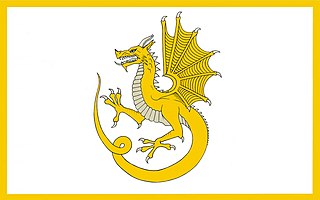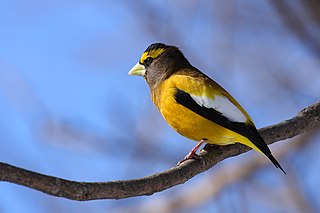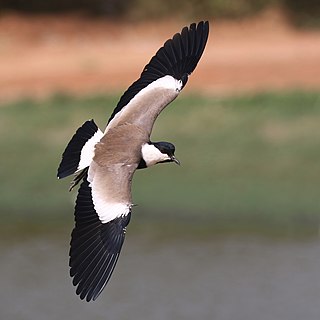
The wyvern is a type of mythical dragon with two legs, two wings, and often a pointed tail which is said to be a venomous stinger.

The common sandpiper is a small Palearctic wader. This bird and its American sister species, the spotted sandpiper, make up the genus Actitis. They are parapatric and replace each other geographically; stray birds of either species may settle down with breeders of the other and hybridize. Hybridization has also been reported between the common sandpiper and the green sandpiper, a basal species of the closely related genus Tringa.

In aeronautics, dihedral is the angle between the left and right wings of an aircraft. "Dihedral" is also used to describe the effect of sideslip on the rolling of the aircraft.

The evening grosbeak is a passerine bird in the finch family Fringillidae found in North America.

The spur-winged lapwing or spur-winged plover is a lapwing species, one of a group of largish waders in the family Charadriidae.

Winger, in the game of ice hockey, is a forward position of a player whose primary zone of play is along the outer playing areas. They typically flank the centre forward. Originally the name was given to forward players who went up and down the sides of the rink. Wingers generally have the least defensive responsibilities out of any position on the ice, however they are still tasked with defensive duties such as forechecking duties or covering the point in the defensive zone.

In Christian tradition, the Four Evangelists are Matthew, Mark, Luke, and John, the authors attributed with the creation of the four canonical Gospel accounts. In the New Testament, they bear the following titles: the Gospel of Matthew; the Gospel of Mark; the Gospel of Luke; and the Gospel of John. These names were assigned to the works by the early church fathers in the 2nd century AD; none of the writers signed their work.

The feathered thorn is a moth of the family Geometridae. It was first described by Carl Linnaeus in 1761.

The Faravahar, also known as the Foruhar (فروهر) or the Farre Kiyâni, is one of the best-known symbols of Zoroastrianism, an Iranian religion. There are various interpretations of what the Faravahar symbolizes, and there is no concrete universal consensus on its meaning. However, it is commonly believed that the Faravahar serves as a Zoroastrian depiction of the fravashi, or personal spirit.

The Talaria of Mercury or The Winged Sandals of Hermes are winged sandals, a symbol of the Greek messenger god Hermes. They were said to be made by the god Hephaestus of imperishable gold and they flew the god as swift as any bird.

The yellow-and-black triplefin, Forsterygion flavonigrum, a triplefin of the genus Forsterygion, is found around the north of the North Island of New Zealand at depths of between 15 and 30 m, in reef areas of broken rock. Its length is between 4 and 7 cm.

The Entognatha are a class of wingless and ametabolous arthropods, which, together with the insects, makes up the subphylum Hexapoda. Their mouthparts are entognathous, meaning that they are retracted within the head, unlike the insects. Entognatha are apterous, meaning that they lack wings. The class contains three orders: Collembola, Diplura and Protura. These three groups were historically united with the now-obsolete order Thysanura to form the class Apterygota, but it has since been recognized that the hexapodous condition of these animals has evolved independently from that of insects, and independently within each order. The orders might not be closely related, and Entognatha is now considered to be a paraphyletic group.

Sinopterus is a genus of tapejarid pterodactyloid pterosaur from the Aptian-age Lower Cretaceous Jiufotang Formation of Chaoyang, Liaoning, China. It was first described and named by Wang Xiaolin and Zhou Zhonghe. Historically, there were multiple species attributed to the genus although only one is considered to be valid. Sinopterus is known for its proportionally large skull, which has a birdlike pointed beak, a long bony crest that starts with a tall premaxilla and goes back along the middle of the skull to form a point overhanging the rear of the skull, and its lack of teeth.

Les Fatals Picards is a French rock/punk band, founded in 1996.

The Erebidae are a family of moths in the superfamily Noctuoidea. The family is among the largest families of moths by species count and contains a wide variety of well-known macromoth groups. The family includes the underwings (Catocala); litter moths (Herminiinae); tiger, lichen, and wasp moths (Arctiinae); tussock moths (Lymantriinae), including the arctic woolly bear moth ; fruit-piercing moths ; micronoctuoid moths (Micronoctuini); snout moths (Hypeninae); and zales, though many of these common names can also refer to moths outside the Erebidae. Some of the erebid moths are called owlets.

The leading edge is the part of the wing that first contacts the air; alternatively it is the foremost edge of an airfoil section. The first is an aerodynamic definition, the second a structural one. As an example of the distinction, during a tailslide, from an aerodynamic point of view, the trailing edge becomes the leading edge and vice versa but from a structural point of view the leading edge remains unchanged.

Anomologinae is a subfamily of moths in the family Gelechiidae.
Spiniductellus is a genus of moths in the family Gelechiidae.

Ambopteryx is a genus of scansoriopterygid dinosaur from the Oxfordian stage of the Late Jurassic of China. It is the second dinosaur to be found with both feathers and bat-like membranous wings. Yi, the first such dinosaur, was described in 2015 and is the sister taxon to Ambopteryx. The holotype specimen is thought to be a sub-adult or adult. The specimen is estimated to have had a body length of 32 centimetres (13 in) and a weight of 306 grams (0.675 lb). The genus includes one species, Ambopteryx longibrachium.

Dearc is a genus of large-bodied rhamphorhynchine pterosaur from the Middle Jurassic Lealt Shale Formation of Scotland. The holotype, a juvenile or subadult that was still actively growing, has an estimated wingspan of 2.5 to 3 meters, making it the largest flying animal of its time. This pushes the origin of large pterosaurs back significantly, as it was previously assumed that pterosaurs did not reach greater body sizes until the short-tailed pterodactyloid lineages of the Cretaceous. The genus contains a single species, Dearc sgiathanach ( ).


















